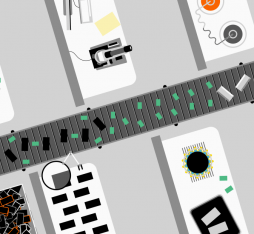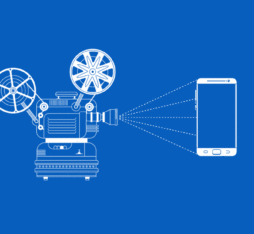Energy efficiency gains versus huge increases in use: sustainable digital technology not yet a reality
Driven by new digital uses such as video playback on smartphones for example, traffic on telecommunications networks and in data centres is skyrocketing and this has consequences in terms of carbon impact. But, hasn’t significant progress been made in terms of the energy efficiency of equipment? What accounts for such energy use?
Anne-Cécile Orgerie: We have indeed made progress in the area of energy efficiency
for various types of IT equipment. However, the number of such equipment has steadily grown, as have their features. Take TV screens, for example: the shift from cathode ray screens to LCD screens has increased the energy efficiency of TV sets. But, at the same time, screen sizes have become significantly bigger such that, at the end of the day, overall energy use has not decreased. This example illustrates the rebound effects: when energy efficiency is optimised, this has indirect effects that can offset energy gains.
Does the problem only relate to IT equipment?
Anne-Cécile Orgerie: No, it also concerns software that are more resource-intensive and applications that use numerous features that are not always indispensable. The problem also has to do with the availability of services online and the impatience of users who use many features, which leads to over-size infrastructure, or even a total redundancy to limit the risks of service interruption as much as possible. Such is the case, for example, with the core of Internet service provider networks which are sized to deal with demand peaks (generally between 9pm and 10pm) and to be able to resist failures of certain equipment that are duplicated. This high availability comes at a high cost.
On the other hand, we often hear that digital technology leads to significant gains in terms of carbon impact. What is the reality?
Anne-Cécile Orgerie: Information and communication sciences and technologies have tremendous tools at their disposal for optimising and improving the processes and operations of many facilities in the fields of transportation, construction and health, to name but a few examples of areas of application. However, these improvements should not come at the cost of oversizing the digital resources used; otherwise resources will be wasted unnecessarily. Similarly, for each improvement, it is necessary to meticulously review the impacts of the use of IT equipment throughout their life cycle to ensure that those impacts do not offset the expected gains.
Ultimately, would you say that digital is rather an opportunity or a challenge for the environment in its current form?
Daniel Kaplan: After 50 years of mass computerisation of society, it must be admitted that digital technology does not have beneficial effects on the environment since our CO2 emissions keep rising. The growth in greenhouse gas emissions has coincided with the movement to computerise society: there isn’t a causal link, but the two phenomena are related; they are two sides of the same accelerating pace of life, of which digital technology is the tool.
We wanted to believe that the environmental costs of digital technology would be offset by gains they would render possible in all areas in terms of efficiency, dematerialisation, etc. Every time digital technology has delivered gains in terms of time or energy savings, such gains have been fully reinvested in a fresh increase in performance, the increasing number of options or personalised services and in the rapid pace of product turnover. Improving the efficiency of a resource can be analysed as a cost reduction, which encourages us to consume more of it, so we lose the associated environmental benefit. This is referred to as the rebound effect.
Conversely, what would be the more virtuous uses of digital?
Daniel Kaplan: Digital technology is not only about computing. It assists us in our daily practices; it is crucial knowledge-acquisition tool and it makes it possible to coordinate independent players on a massive scale (from Wikipedia to sharing platforms). That’s probably where the main opportunities for change are: involving people in the environmental initiatives, organising circular and local networks, promoting ambitious forms of sharing and pooling… But, if the public sector and business do not make deliberate choices, nothing will be possible: digital technology will remain a tool for exacerbating the current productivist development model.
Digital players also need to work on themselves. That is the aim of the RESET project launched by Fing and several dozen businesses and associations to “reinvent digital technology”.
Can we take action at the individual level and if so, how? Can we reduce our use, as recommended by the authors of the Shift Project with their “digital sobriety” principle?
Anne-Cécile Orgerie: As users, there are two things we can do with respect to the use of equipment: avoiding waste and extending the lifespan of our equipment. The first point has to do with optimising the use of our equipment: turning them off completely when not in use, deleting useless data, uninstalling unused applications, reducing the number of programmes and tabs opened simultaneously, and so forth. The second point involves repairing, reusing and making our equipment last longer. Equipment production of is impactful (extraction of materials, production process, transportation).
Daniel Kaplan: We can always tell people “be sober in how your use of digital”, but we should start with companies by asking them to stop creating addictive devices. If we pontificate while supporting approaches that create loyalty to applications, services and addictive games or that promote the rapid equipment turnover, we are being totally contradictory and doing the opposite of what we recommend. So, there will be far greater environmental benefits to be derived from not offering addictive devises than from lecturing people.
Business therefore has a big role to play?
Daniel Kaplan: Exactly. Internally, some things have already been done: the IT services of some major companies like Orange have done a remarkable job and made advances in areas of resource use, waste reduction and treatment and the pace of equipment turnover. This is a crucial factor in dealing with environmental issues. Today these efforts have to be continued, including when dealing with the new IT waves linked to Big Data and the Internet of Things that lead to exponential energy use.
And in terms of public policies?
Daniel Kaplan: Public strategies to support innovation can be improved. Currently, there is a mere “green box” in some of them, while the question of the environmental impact of innovative projects is not posed with any seriousness. We think there is a pressing need that an environmental conditionality be attached to some forms of public support for innovation. There is also a positive green innovation trend, but it is not sufficiently equipped as concerns the issue of the impact of the innovations in question. Fing has come up with the first version of a standard, “Factor 4 Innovation” which seeks to offer an accessible way to take action, including to all small start-ups. But it’s quite a new and recent development.
Anne-Cécile Orgerie is a research scientist at CNRS. She is interested in large-scale distributed systems such as clouds and large data processing networks, which interconnect a significant amount of computing and storage resources to deliver services to users via the Internet. Her work focuses more specifically on the energy efficiency of such systems: reducing their energy use and mitigating their environmental impact.
A co-founder of the Next generation internet foundation (Fing), Daniel Kaplan leads the project to set up the Plurality University. In 2018 he helped draft the White paper on the “Digital technology and environment” together with Fing, WWF, Iddri, GreenIT.fr and the French digital council Conseil national du numérique.
Orange is reducing its carbon footprint
Digital sobriety? “It is about using digital technology only when it is really necessary”, explains Philippe Tuzzolino, Head of Environmental Affairs at Orange. Not by leaving it up to the customer alone to shoulder the responsibility, but with means such as service design: ensuring, for example, that the operator is able to turn off his/her box when he/she discovers that the customer is not using it. Through its initiatives to promote the energy efficiency initiatives not only of its technical equipment, but also of its building stock and its vehicle fleet, Orange managed to reduce by 56% its CO2 emissions per customer usage between 2006 and 2016 whereas its customer base almost doubled over the period, from 135 to 264 million customers. The target of reducing this type of emissions by 50% between 2006 and 2020 has therefore already been hit. The operator does not intend to stop there as carbon neutrality has become an issue not only of corporate social responsibility, but also of competitiveness: with environmental clauses becoming ever so strict in calls for tenders, “the operator that becomes carbon neutral will reap the benefits”, Philippe Tuzzolino predicts. Among the projects launched by Orange to achieve actual carbon neutrality (without resorting, with some exceptions, to offsets or the neutral certificates system), there is the target of using 100% renewable energy by 2030 for Orange’s MEA region and by 2050 in Europe. There also is the integration of the circular economy into the organisation and its processes as well as assistance to Orange suppliers and customers in a move towards ecological transition. This will drive energy efficiency innovations in the coming years.
For further information:
Philippe Tuzzolino: “invent a sober digital service” (Orange)
How Orange is reducing its environmental footprint
Orange is reducing its carbon footprint (computer graphics)











